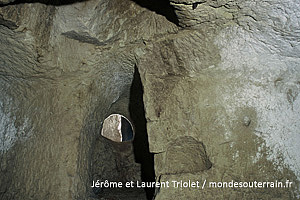 Underground refuges (souterrains-refuges)
Underground refuges (souterrains-refuges)
The underground refuges constituted local underground fortresses, dug during murky chapter in history, made in our country to shelter a community (inhabitants of farm, of hamlet, of little castle) and also with all means of subsistence (live stock, grain). It was difficult to take the underground refuge without heavy losses in men. It was a good way to protect them from pillagers. Thanks to defense systems we can classify them in 2 groups : underground refuge with passive defense (the most ancient of them date from 13th century) and underground refuges with active defense (they date from 14th-16th century).
The defense systems in the underground refuges with passive defense is composed by several obstacles (doors, narrow passages) or by traps (wells, silos). The defense system in the underground refuges with active defense is more complex using loopholes. For example, because of fire through the loopholes, the assailant was not able to destroy the doors and enter the rooms.
|